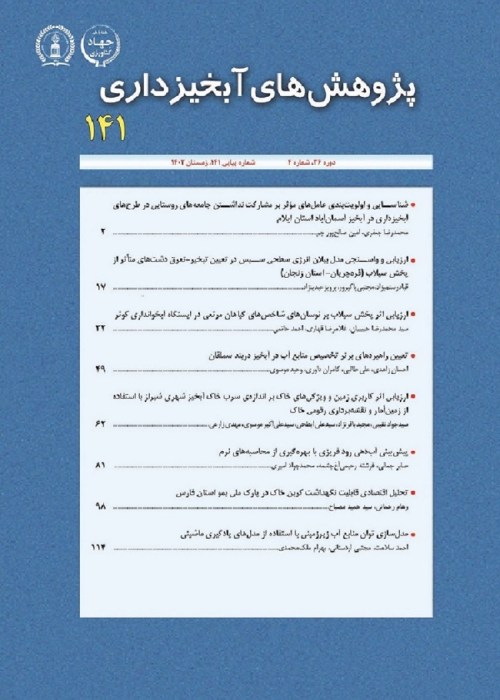Prioritization of Effective Factors and Flood Susceptibility Zonation Using Probabilistic Models and GIS in Gorganrood Watershed Golestan Province
Floods and earthquakes are the most common and unpredictable natural events that harm communities by affecting life and property and affect the landforms of the basin. Therefore, in ways to reduce the effects of natural events, The main goal has changed to public awareness and emphasis on informing the people in line with preventive measures before the occurrence of abnormal events. Considering these explanations and the need to compare and evaluate the effectiveness of probabilistic statistical methods, The main goal of this research is to investigate the morphological, hydrological and climatic factors affecting the occurrence of floods, Modeling and evaluation of land sensitivity potential in Gorganrood watershed to flood occurrence. Also, the most important innovation of the current research compared with to the previous researches related to risk zonation in the country, the comparison of two probabilistic methods of Shannon entropy and weight of evidence in order to determine the most efficient model and increase the accuracy of flood prediction maps.
1- Selection of the study area, Collecting and preparing maps of effective factors as independent variables, 15 factors were considered in this research. 2- The flood event distribution map was prepared using the information received from the Ministry of Energy and field observations as a dependent variable, and it was divided into two groups of test points (30%) and training points (70%). 3- Quantifying the effective factors with the help of the frequency ratio index and also performing the multilinear test (independence of the effective factors). 4- Implementation of entropy and weight of evidence models, Preparation of flood sensitivity zoning maps and classifying them into five categories: very low, low, medium, high and very high. 5- Assessing the accuracy of classification and validation of zoning maps and predicting sensitivity to flood events. 6- Determining the importance of effective factors and choosing the most suitable model.
In total, based on the calculated weights of both entropy index and weight of evidence models, in the order of factors land use, altitude, Normalized difference vegetation index (NDVI), soil, Topographic Wetness Index (TWI), Drainage density, Stream power index, slope (SPI), Topographic position index (TPI), lithology, average annual precipitation, Infiltration number, Profile curvature, Stream frequency and Intensity of daily rainfall are effective in flood occurrence. In this research, the land use factor and then the vegetation cover factor have a high priority in the occurrence of floods due to land use changes. The intensity of rainfall is in the last rank, but its importance and influence should not be ignored along with other factors. The maps resulting from flood risk zonation by both models indicate the high accuracy of zone classification and proper distribution of flood points in high and very high zone. Also, based on the receiver operator characteristic (ROC) curve and accuracy classification levels, the efficiency of both models is in the very good category (0.8-0.9) In terms of comparing the models to each other, the results of the area under the curve (AUC) values of the Shannon entropy model show a higher score accuracy in both testing and training situations (0.94 and 0.98) than the Bayesian weighting method (83.83). 0 and 0.88) which indicates a high correlation between the prepared flood sensitivity map and the distribution map of the number of flood events.
Conclusion and Suggestions:
In this research, in order to prepare a map of flood event zoning, 368 flood zones with a repetition number of 782 flood events and 15 factors affecting flood events were used. Based on the fitting of both models and the prioritization of the factors affecting the occurrence of floods, it was determined altogether that land use, altitude and vegetation factors have importance and priority in the occurrence of floods in the study area and Profile curvature, Stream power index and Intensity of daily rainfall factors were placed in the last priorities. The results showed that Shannon's entropy model has the appropriate class threshold in classification, and by using 30% of flood occurrence zones, it has more priority for zonation and flood occurrence prediction. But in general, both models are effective in zoning and predicting flood occurrences.
- حق عضویت دریافتی صرف حمایت از نشریات عضو و نگهداری، تکمیل و توسعه مگیران میشود.
- پرداخت حق اشتراک و دانلود مقالات اجازه بازنشر آن در سایر رسانههای چاپی و دیجیتال را به کاربر نمیدهد.



